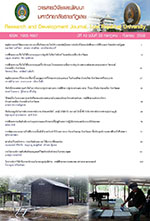การพัฒนากระบวนการในพิธีกรรมเลี้ยงผีเจ้านายประจำปีบ้านทรายขาว อำเภอวังสะพุง จังหวัดเลย เพื่อประยุกต์การแสดงฟ้อนเจ้าฟ้าฮ่มขาว
Keywords:
พิธีกรรม, ฟ้อนเจ้าฟ้าฮ่มขาว, ceremony, White-robed wearing clothes of Chow PhaAbstract
การวิจัยครั้งนี้มีวัตถุประสงค์เพื่อพัฒนา นวัตกรรมการแสดงฟ้อนพิธีกรรมเลี้ยงผีด้วยสื่อศิลปะพื้นบ้านให้มีพลังแบบพลวัตรแบบศิลปะร่วมสมัย จากศิลปะพื้นบ้านด้วยเทคนิค วิธีการ ตามรูปแบบของระบาที่ปรับปรุงขึ้น โดยให้คนในชุมชนมีส่วนร่วมเพื่อการให้ข้อมูลจากประเพณี พิธีกรรม ความเชื่อ ศรัทธา เก็บข้อมูลด้วยวิธีการสังเกตและการสัมภาษณ์ จากกลุ่มตัวอย่าง เช่น ขะจ้า นางเทียม นางแต่ง สมุน พราหมณ์ ผู้รู้ ผู้ทรงคุณวุฒิ และผู้นำทางสังคมและวัฒนธรรม เช่น ข้าราชการ พระสงฆ์ นายกองค์การบริหารส่วนตาบลทรายขาว ผู้มีส่วนเกี่ยวข้องกับการนาเครื่องดนตรีบรรเลงประกอบ การแสดงการฟ้อนรำเฉลิมฉลองผลการวิจัยพบว่า องค์ประกอบพิธีกรรมเลี้ยงผีเจ้านาย เจ้าฟ้าฮ่มขาวมีระเบียบและขั้นตอนที่เคร่งครัดยึดถือตามแบบประเพณีปฏิบัติดั้งเดิมของชาวเมืองเลยในอดีต
ส่วนองค์ประกอบทางดนตรีที่ใช้บรรเลงประกอบ ใช้เครื่องดนตรีพื้นบ้านที่คิดขึ้นเอง บรรเลง ทำนองจังหวะ อารมณ์เพลงที่เรียกว่า ทำนองลายสุดสะแนน ทั้งช้าและเร่งจังหวะ ซึ่งเคยใช้ประกอบพิธีกรรมเลี้ยงผีฟ้าและเลี้ยงผีประจำปี นำมาจัดระเบียบและตัดทอนทำนองเพลง และจังหวะให้อารมณ์เพลงมีความเหมาะสมกับการแสดงที่มีท่าฟ้อนรำ สร้างเครื่องแต่งกายและอุปกรณ์ประกอบการแสดงนำแบบแผนมาจากการจัดพิธีกรรมจริง โดยเลือกใช้เพื่อเป็นสัญลักษณ์ที่เป็นภูมิปัญญาดั้งเดิม ถ่ายทอดผ่านพิธีกรรมให้มีคุณค่า มีความหมายตรงเป็นสะพานเชื่อมโยงจากวัฒนธรรมเก่าสู่ความงดงามแบบศิลปะร่วมสมัย ให้ศิลปะนำพาวัฒนธรรมแบบ 2 มิติทางวัฒนธรรม จากไม่มีรูปให้เป็นรูปธรรมในการแสดงฟ้อนเจ้าฟ้าฮ่มขาว ดังนี้ มิติที่ 1 ภาคพื้นดิน เป็นภาพจาลองเหตุการณ์การสักการะเซ่นไหว้ประกอบด้วย นางเทียม สมุน นางแต่ง ประกอบพิธีอัญเชิญวิญญาณผีบรรพบุรุษให้มาร่วมพิธีกรรมเลี้ยงผีเจ้านายประจาเมือง โดยรวมขั้นตอนที่ 1 พิธีกรรมเซ่นไหว้ และขั้นตอนที่ 2 พิธีกรรมฉลอง มิติที่ 2 ภาคสวรรค์ ประกอบด้วยภาพจำลองเหตุการณ์ ประกอบด้วยตัวละคร เจ้าฟ้า ฮ่มขาว มเหสี และบริวารนางอัปสร ลงมารับรู้ประเพณีกินเลี้ยงและเซ่นไหว้ ตามคาเชิญของนางเทียม สมุน นางแต่ง โดย เจ้าฟ้าฮ่มขาวเป็นเทพ เทวดา เป็นมเหศักดิ์หลักเมือง อวยชัยให้พรกับผู้ประกอบพิธีกรรมและผู้ร่วมพิธีกรรมให้ประสบผลสำเร็จ ดำเนินชีวิตและประกอบอาชีพทางการเกษตรกรรมที่สมบูรณ์ต่อไป
A Research Project and Folklore Performance on Artistic Development from Spirit Offerings Ceremony as White-robed Wearing Clothes of Chow Pha
This research was aimed at dancing innovative creation with the folklore artistic communication as to be officiously strengthened as contemporary artistic model. The community took part in this project and data collection rose from traditional ritual, to combine with observations and interviews through sampling groups such as solemnized people (Khajan), healer (“Nangtiem”), adorners, attendants, Brahmin, educators, qualified persons who were social and cultural leaderships, namely government officials, Buddhist monks, Sai-khow sub-district administrative organization leaders, and participants who related to the ceremony and performance celebration.
This research’s consequences found that some annually sacrificial ritual ingredients or annually guardian spirit scarifying as known as white-robed god contained several rules and satiety performing by holding on it according to original traditions and customs of the people who lived in Loei or their ancient city of Loei itself. As for the musical components that had been used for singing and playing, musical instruments were in the form of its chorus, some of rhythm, emotional tune that used to sing as mixed in the Pee Phars ritual an annually spirit sacrificial offerings. This could be managed on rules and exercised the ritual ceremony by mixing the song with dancing styles. To design on some of attires and to use various suitable instruments that could be conveyed its meaning into practice were followed the guidline of some of ancestors' folk knowledge that succeeded from one generation to generation as concerned with the ritual. Such a ritual contained with much values and more meanings and brought about spirit as a bridge to link old culture with contemporary artistic beauties. Its meanings concerned mostly with thinking method as an art brought about cultures possessed two dimensions. They were thinking methods that dealt with cultures as shown some of the suitable cloths of chow Pha’s white-robed waring in the annually sacrificial ceremonies as follows.
The first dimension refered definitely to the earth that consisted of henchmen and healer (“Nangtiem”), solemniser a woman who prepared some of sacrifices and worshiping also with offerings in order to invite their ancestors' soul to come to join in the ceremony as known as annually spirit's offerings to follow up in the first stage of the offerings and in the end, they offered food to one another.
The second dimension referred to the heaven that consisted of king's soul-picture remained in the white-robed cloths, the queen and adorned, goddees came down to know and accepted the annually spirits offerings related to the invitation as above mentioned. The aforesaid ritual made use of more benefits for the people who respected toward gods that would be in a success of earning a living of the people themselves on the agricultural occupation onwards.
Downloads
How to Cite
Issue
Section
License
ข้อความที่ปรากฎในวารสารฉบับนี้เป็นความคิดเห็นของผู้เขียนแต่ละท่าน สถาบันวิจัยและพัฒนา มหาวิทยาลัยราชภัฏเลย และกองบรรณาธิการ ไม่จำเป็นต้องเห็นด้วยและไม่มีส่วนรับผิดชอบใดๆ
สถาบันวิจัยและพัฒนา มหาวิทยาลัยราชภัฏเลย ขอให้ผู้อ่านอ้างอิงในกรณีที่ท่านคัดลอกเนื้อหาบทความในวารสารฉบับนี้



